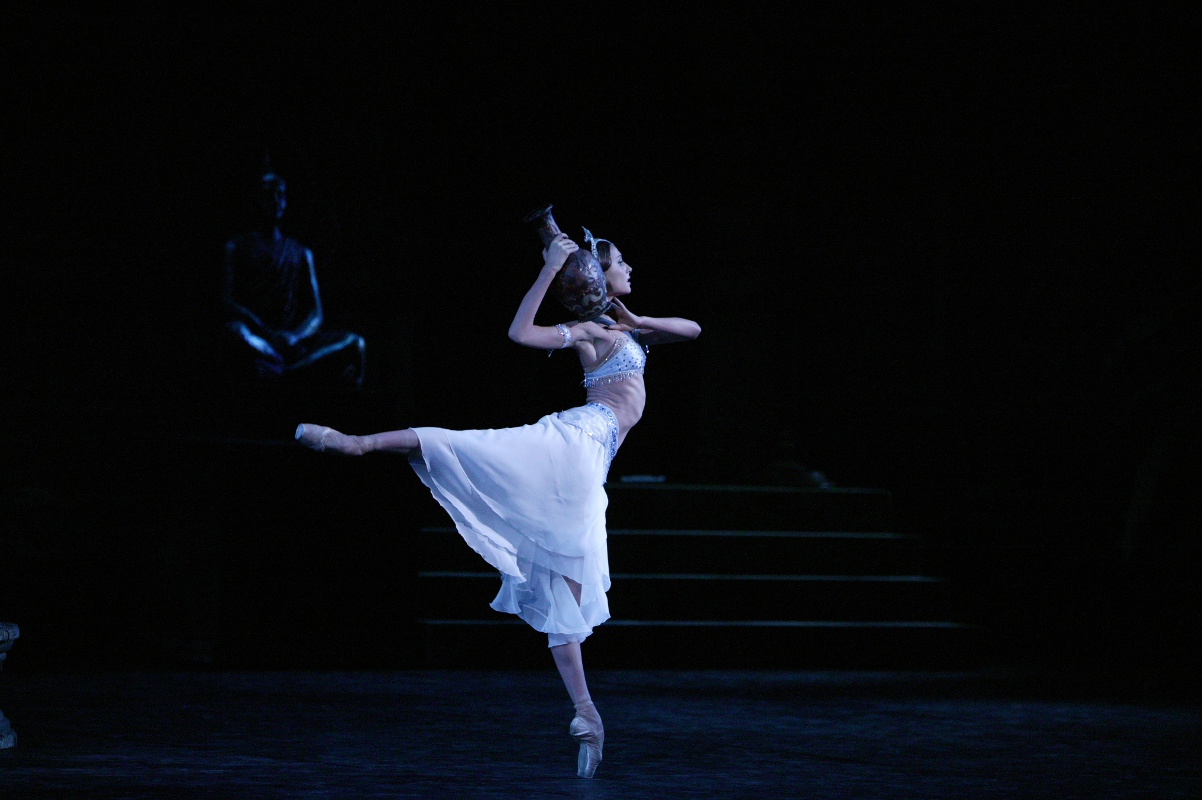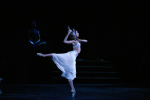Bayadere
La Bayadere
Bolshoi Ballet’s LA BAYADÈRE
Ludwig Minkus | Ballet in Three Acts
From the Bolshoi Ballet | Running time 210 minutes including two intermissions
La Bayadère (“The Temple Dancer”), from the Bolshoi Ballet, tells the story of impossible love between
the dancer Nikiya and the warrior Solor, set against the backdrop of lush, exotic India. Marius Petipa’s
choreography, here in a new scenic version by Yuri Grigorovich, is exquisite; especially noteworthy is the
scene known as The Kingdom of the Shades, one of the most celebrated excerpts in ballet, and one of the
first examples of “abstract ballet.” Cast to be announced in January 2013.
February 3 & 5, 2013
Cast will be announced in 2013.
CREATIVE
Music: Ludwig Minkus
Libretto: Marius Petipa and Sergei Khudekov
Conductor: Pavel Sorokin
Choreography: Marius Petipa
New scenic version: Yuri Grigorovich
With scenes from productions by: Vakhtang Chabukiani, Nikolai Zubkovsky, Konstantin Sergeyev
Sets after sketches by designers of the 1st production (1877) revived by: Valery Firsov, Nikolai Sharonov
Costumes after sketches by designers of the 1st production (1877) revived by: Nikolai Sviridchikov
Supervisor of scenery and costumes revival: Valery Levental
Music Director: Alexander Kopylov
With the Orchestra of the State Academic Bolshoi Theatre of Russia
With the Bolshoi soloists and the Bolshoi Corps de Ballet
Performed on January 27, 2013
PROGRAM NOTE
Marius Petipa (France 1818 - 1910) is considered to be the most influential ballet master and
choreographer of ballet in history. Noted for his long career as Premier Maître de Ballet of the St.
Petersburg Imperial Theatres (1871-1903), Petipa created over fifty ballets and revived a substantial
number of works by other Ballet Masters. Most of his choreographies are cornerstones within the classical
ballet repertory.
After being accepted into the Leningrad Ballet School in 1946, Yuri Grigorovich went on to become a
soloist at the Kirov Ballet of St. Petersburg where he stayed until 1962. He joined the Bolshoi Theatre in
1964 and was Artistic Director until 1995. His most famous works are Nutcracker, Spartacus and Ivan the
Terrible.
Marius Petipa's seminal work La Bayadère was first performed at the Imperial Bolshoi Kamenny Theatre
in St. Petersburg in 1877 in a grandiose production portraying a mysterious India and the impossible love between the sacred dancer Nikiya and the warrior Solor. A scene from the ballet, known as The Kingdom
of the Shades, is one of the most celebrated excerpts in all of classical ballet, and is considered to be one of
the first examples of abstract ballet. Although a major work in Russian tradition, the ballet remained
unknown for a long time in the West.
SYNOPSIS
Act I
Young warriors led by Solor are hunting. Before entering the forest, Solor sends a fakir to tell bayadère
Nikiya (a temple dancer) that he will meet her later at night. When Nikiya and Solor meet, they swear
eternal fidelity to each other. They are unaware that the High Brahmin also in love with Nikiya, overhears
them and decides to take revenge. He rushes to reveal this secret to the Rajah who has selected Solor to be
the fiancé of Gamzatti, his beloved daughter. Nikiya, unaware of the arrangement, agrees to dance at the
couple's betrothal celebrations.
The jealous High Brahmin in – an effort to have Solor killed and have Nikiya for himself – tells the Rajah
that the warrior has already vowed love to the bayadère over. But the Rajah, rather than becoming angry
with Solor, vows that Nikiya must die. Gamzatti, who has eavesdropped on this exchange, summons
Nikiya to the palace in an attempt to bribe her into giving up her beloved. As their rivalry intensifies,
Nikiya picks up a dagger in a fit of rage and attempts to kill Gamzatti. Nikiya is stopped at the last
moment and flees in horror at what she has almost done. As did her father, Gamzatti vows that the
bayadère must die…
Act II
A sumptuous feast is being held on the occasion of Solor and Gamzatti’s engagement. Nikiya is supposed
to entertain the guests with dances. It is impossible to hide her grief while she dances and her eyes are
fixed on her beloved Solor.
Following Gamzatti’s plan, the fakir presents Nikiya with a basket of flowers on behalf of Solor. Suddenly,
the bayadere’s dance is filled with happiness. As she joyfully dances for the guests, a snake crawls out
of the flower basket and bites her fatally. Nikiya realizes that the Rajah’s daughter Gamzatti is to blame
for her death. The High Brahmin promises to save her life if she will love him. But Nikiya is faithful to her
love for Solor, and she dies. Solor leaves the feast in utter despair.
Act III
Solor is inconsolable and filled with remorse. He asks the fakir to distract him from his grieving thoughts
in bringing him opium to smoke. Solor peacefully sinks into the world of dreams, fascinated by sacred
dance.
Shadows appear to him out of the darkness. They are descending from mountains in a seemingly endless
file. Solor sees the fair Nikiya among them and they dance a beautiful pas de deux. There is no more
reality for Solor. He follows in the shadow of his beloved Nikiya.
Ludwig Minkus | Ballet in Three Acts
From the Bolshoi Ballet | Running time 210 minutes including two intermissions
La Bayadère (“The Temple Dancer”), from the Bolshoi Ballet, tells the story of impossible love between
the dancer Nikiya and the warrior Solor, set against the backdrop of lush, exotic India. Marius Petipa’s
choreography, here in a new scenic version by Yuri Grigorovich, is exquisite; especially noteworthy is the
scene known as The Kingdom of the Shades, one of the most celebrated excerpts in ballet, and one of the
first examples of “abstract ballet.” Cast to be announced in January 2013.
February 3 & 5, 2013
Cast will be announced in 2013.
CREATIVE
Music: Ludwig Minkus
Libretto: Marius Petipa and Sergei Khudekov
Conductor: Pavel Sorokin
Choreography: Marius Petipa
New scenic version: Yuri Grigorovich
With scenes from productions by: Vakhtang Chabukiani, Nikolai Zubkovsky, Konstantin Sergeyev
Sets after sketches by designers of the 1st production (1877) revived by: Valery Firsov, Nikolai Sharonov
Costumes after sketches by designers of the 1st production (1877) revived by: Nikolai Sviridchikov
Supervisor of scenery and costumes revival: Valery Levental
Music Director: Alexander Kopylov
With the Orchestra of the State Academic Bolshoi Theatre of Russia
With the Bolshoi soloists and the Bolshoi Corps de Ballet
Performed on January 27, 2013
PROGRAM NOTE
Marius Petipa (France 1818 - 1910) is considered to be the most influential ballet master and
choreographer of ballet in history. Noted for his long career as Premier Maître de Ballet of the St.
Petersburg Imperial Theatres (1871-1903), Petipa created over fifty ballets and revived a substantial
number of works by other Ballet Masters. Most of his choreographies are cornerstones within the classical
ballet repertory.
After being accepted into the Leningrad Ballet School in 1946, Yuri Grigorovich went on to become a
soloist at the Kirov Ballet of St. Petersburg where he stayed until 1962. He joined the Bolshoi Theatre in
1964 and was Artistic Director until 1995. His most famous works are Nutcracker, Spartacus and Ivan the
Terrible.
Marius Petipa's seminal work La Bayadère was first performed at the Imperial Bolshoi Kamenny Theatre
in St. Petersburg in 1877 in a grandiose production portraying a mysterious India and the impossible love between the sacred dancer Nikiya and the warrior Solor. A scene from the ballet, known as The Kingdom
of the Shades, is one of the most celebrated excerpts in all of classical ballet, and is considered to be one of
the first examples of abstract ballet. Although a major work in Russian tradition, the ballet remained
unknown for a long time in the West.
SYNOPSIS
Act I
Young warriors led by Solor are hunting. Before entering the forest, Solor sends a fakir to tell bayadère
Nikiya (a temple dancer) that he will meet her later at night. When Nikiya and Solor meet, they swear
eternal fidelity to each other. They are unaware that the High Brahmin also in love with Nikiya, overhears
them and decides to take revenge. He rushes to reveal this secret to the Rajah who has selected Solor to be
the fiancé of Gamzatti, his beloved daughter. Nikiya, unaware of the arrangement, agrees to dance at the
couple's betrothal celebrations.
The jealous High Brahmin in – an effort to have Solor killed and have Nikiya for himself – tells the Rajah
that the warrior has already vowed love to the bayadère over. But the Rajah, rather than becoming angry
with Solor, vows that Nikiya must die. Gamzatti, who has eavesdropped on this exchange, summons
Nikiya to the palace in an attempt to bribe her into giving up her beloved. As their rivalry intensifies,
Nikiya picks up a dagger in a fit of rage and attempts to kill Gamzatti. Nikiya is stopped at the last
moment and flees in horror at what she has almost done. As did her father, Gamzatti vows that the
bayadère must die…
Act II
A sumptuous feast is being held on the occasion of Solor and Gamzatti’s engagement. Nikiya is supposed
to entertain the guests with dances. It is impossible to hide her grief while she dances and her eyes are
fixed on her beloved Solor.
Following Gamzatti’s plan, the fakir presents Nikiya with a basket of flowers on behalf of Solor. Suddenly,
the bayadere’s dance is filled with happiness. As she joyfully dances for the guests, a snake crawls out
of the flower basket and bites her fatally. Nikiya realizes that the Rajah’s daughter Gamzatti is to blame
for her death. The High Brahmin promises to save her life if she will love him. But Nikiya is faithful to her
love for Solor, and she dies. Solor leaves the feast in utter despair.
Act III
Solor is inconsolable and filled with remorse. He asks the fakir to distract him from his grieving thoughts
in bringing him opium to smoke. Solor peacefully sinks into the world of dreams, fascinated by sacred
dance.
Shadows appear to him out of the darkness. They are descending from mountains in a seemingly endless
file. Solor sees the fair Nikiya among them and they dance a beautiful pas de deux. There is no more
reality for Solor. He follows in the shadow of his beloved Nikiya.
Played at
Claremont 5 2.17.13 - 2.19.13
Playhouse 7 2.17.13 - 2.19.13
Monica Film Center 2.17.13 - 2.19.13
Town Center 5 2.17.13 - 2.19.13
NoHo 7 2.17.13 - 2.19.13
La Bayadere Get Tickets
There are currently no showtimes for this film. Please check back soon.

